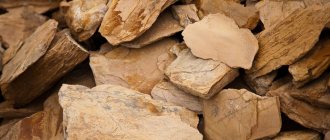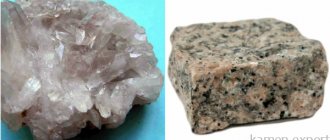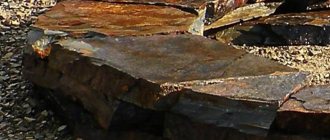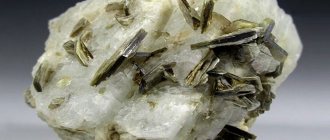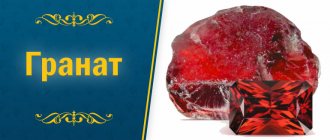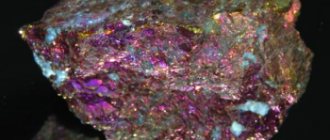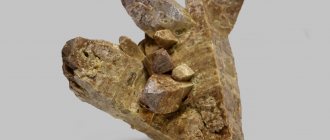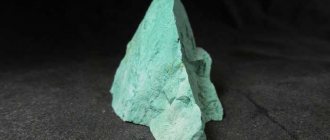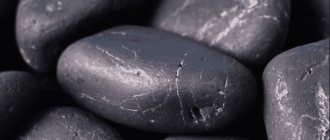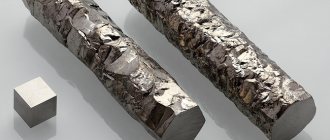Slate rock: description, origin, properties
Slate rock photo
Slate is a rock that is several hundred million years old.
The formation of this mineral occurred either in the bowels of the earth as a result of active volcanic processes, or deep under water, when silt and clay formations that sank to the bottom were compressed under high pressure.
Natural slate consists of plates, the structure of which contains quartz inclusions and feldspar particles. Mica schists are distinguished by the presence of mica in their composition.
Depending on what underlies it, rocks can exhibit different physical properties.
For example, different samples may show completely different levels of hardness. Some of them score 2 on the Mohs scale, while others score 6.
The natural mineral also has different thermal conductivities. So, there are rocks that burn well, and there are absolutely fireproof ones.
The same applies to indicators such as water resistance and resistance to various external influences.
Shale deposits are distributed throughout the world. Particularly large deposits have been found in North and South America, in some countries of Europe and Central Asia. On the territory of the Russian Federation, production is mainly carried out in the Siberian region, the Urals and the North Caucasus.
Shale oil - oil of 2 types (according to the classification accepted in the USA):
- Shale oil is a highly viscous shale resin that is significantly different in density and viscosity from traditional oil. Obtained from oil shale after thermal exposure;
- Tight oil - light oil contained in dense, low-porosity and low-permeability reservoirs
The search for shale oil requires new technologies because hydrocarbons are present without a visible seal, are not confined to uplift and without the classic gas-oil-water contact.
Variety of slate types
According to the main classification, shales are divided into clayey and crystalline.
Clay rocks are most often dark gray or green in color. The compressed clay contains inclusions of quartz, sulfur pyrite, lime spar, mica, rutile and many other minerals.
There are separate groups that are formed according to criteria such as structure, composition and physical properties:
- Gray roofing and black slate (or black mountain slate). They are easily separated into plates and are widely used in various technical fields.
- Slate slate is quite soft and is divided into oblong columns. The color of the slate slates is grey.
- The greenish grinding variety is distinguished by its high hardness and high silica content.
- The soft black drawing mineral contains a lot of carbonaceous matter. And the alum variety is also rich in sulfur pyrites.
Crystalline schists have a denser structure and, due to the presence of dark-colored minerals, have a corresponding color.
Sometimes inclusions of quartz or feldspar are found in the composition, which explains the presence of light stripes. Sometimes completely white slate is also found.
Oil shale deposits:
The main resources are concentrated in the USA (Colorado, Utah, Wyoming) and are associated with the Green River formation. Large basins are found in Brazil (Irati, Paraiba), China (Fushun), Russia (Baltic, Volzhsky, Vychegda, Timan-Pechora, Syrdarya, Amudarya basins, Kenderlyk and Bazhenov fields). Numerous oil shale deposits have been found in Bulgaria, Great Britain, Germany, France, Spain, Austria, Canada, Australia, Italy, Sweden, Kazakhstan, Ukraine, and Yugoslavia.
Application of slate stone
Slate building stone
Natural slate has long been actively used as a finishing material in the construction of buildings, in landscape design, and for the interior decoration of houses. For example, siltstone shale, the development of which began in the 19th century, was used in the construction of St. Isaac's Cathedral in St. Petersburg. Siltstone plates have a unique color (beige-burgundy, sometimes pink) and an interesting texture.
Crystalline varieties of the rock perform well as a building material. They withstand low temperatures and withstand exposure to ultraviolet rays. This material is very strong and will last a very long time. In addition, it has high sound insulation and excellent heat retention in the room.
Oil shale is used not only as fuel, but also as a raw material for the chemical industry. It is distinguished by its low density and a variety of color options (from gray-yellow to black). However, the active use of this material is hampered by a rather expensive extraction process, attempts to improve which do not stop.
Content
- 1 Origin
- 2 Historical information
- 3 Deposit
- 4 Physical properties
- 5 Varieties
- 6 Chemical composition of shungite used as a sorbent
- 7 Application 7.1 Metallurgy
- 7.2 Construction
- 7.3 Water filtration
- 7.4 Alternative medicine
The healing properties of slate
In addition to its qualities, which are used in various fields of industry and construction, slate also has some healing properties.
It has long been noticed that if you are in a room decorated with this material, your nervous system calms down, your well-being improves, and stress is relieved.
If you heat a piece of such a stone and apply it to a sore spot, the unpleasant symptoms will go away. In addition, it is useful to drink water infused with it.
Major shale oil provinces:
- Bakken Formation, Niobrara Formation, Barnett and Eagle Ford in the USA,
- R'Mah formation in Syria,
- Sargelu Formation in the northern Persian Gulf,
- Athel Formation in Oman,
- Arkaringa Basin in Australia,
- Chicontepec Formation in Mexico,
- Vaca Muerta oil field in Argentina.
In Russia, the analogue of tight oil shale deposits are the following strata:
- Bazhenov Formation in Western Siberia,
- Aachimov deposits in Western Siberia,
- Domanik deposits of the Volga-Ural oil and gas province,
- Khadum Formation of Ciscaucasia, etc.
Russian shale strata:
- also represented by siliceous-clayey-carbonate rocks enriched in organic matter and other components of oil in a dispersed state (micro-oil).
- organic matter in rocks belongs to the category of “weakly and moderately concentrated” and amounts to 2.5-10%, reaching 20-40%.
The use of traditional production technologies, traditional technologies for removing hydrocarbons from oil and gas source rocks into traditional oil and gas traps does not produce results. More than 70% of the generated hydrocarbons remain in the matrix of the generating strata.
Notes
- Borisov P. A. Karelian shungites
. - Petrozavodsk: State Publishing House of the Karelo-Finnish SSR, 1956. - Parfeneva ( sic
) L. S., Volkonskaya T. I., Tikhonov V. V., Kulikova I. N., Smirnov I. A., Rozhkova N. N., Zaidenberg A. Z. Thermal conductivity, heat capacity and thermopower of shungite carbon // Solid state physics. - 1994. - T. 36, No. 4. - P. 1150-1153. - Gorshtein A. E., Baron N. Yu., Syrkina M. L. Adsorption properties of shungites // News of universities. Chemistry and chemical technology. - 1979. - T. 22, No. 6. - P. 711-715.
- Parfenyeva ( sic
) L. S., Smirnov I. A., Zaidenberg A. Z., Rozhkova N. N., Stefanovich G. B. Electrical conductivity of shungite carbon // Solid State Physics. - 1994. - T. 36, No. 1. - P. 234-236. - Shpilevsky M. E., Shpilevsky E. M., Stelmakh V. F. Fullerenes and fullerene-like structures // Engineering-physical journal. - 2001. - T. 76, No. 6. - P. 25-28.
- Mosin O.V., Ignatov I. Composition and structural properties of the natural fullerene-containing mineral shungite mined in Russia // Nanoengineering. - 2012. - No. 6. - P. 17-23.
- Alternative to coke (undefined)
(inaccessible link). MetalTrade (March 15, 2011). Date accessed: August 6, 2013. Archived March 6, 2021. - Mosin O.V., Ignatov, I. Application of the natural fullerene-containing mineral shungite in construction and construction technologies // Nanotechnologies in construction. - 2012. - No. 6. - P. 22-34
- Panov P. B., Kalinin A. I., Sorokoletova E. F., Kravchenko E. V., Plakhotskaya Zh. V., Andreev V. P. Use of shungites for drinking water purification. Petrozavodsk: Karelian Scientific Center of the Russian Academy of Sciences, 2007. p.103.
- Mosin O.V., Ignatov, I. Natural fullerene-containing mineral sorbent shungite in water treatment and water purification/Pure water: problems and solutions. 2012. No. 6. P. 109-115.
- The official portal of government authorities of the Republic of Karelia.
- Dmitry Dzhagarov.
Alchemy of “magic soot” - prospects for the use of C60 fullerene in medicine (Russian).
Biomolecule
. Date accessed: February 9, 2021. - Berezkin V.I. Carbon: closed nanoparticles, macrostructures, materials. - SPb.: ARTEGO, 2013. - 450 p. — ISBN 978-5-91014-051-0
- On assigning names to elements of the road network of the Petrozavodsk urban district and introducing amendments to the resolution of the Administration of the Petrozavodsk urban district dated May 10, 2016 No. 1900 - Administration of the Petrozavodsk urban district (unspecified)
. petrozavodsk-mo.ru (July 4, 2016). Access date: November 12, 2016. - drdisrespect on shungite (Russian) (undefined)
. Access date: June 15, 2021.
Historical information
The first episodic descriptions of the rocks of the “black Olonets land” were undertaken in 1792 by academician Nikolai Ozeretskovsky and in 1848 by staff captain of the Corps of Mining Engineers N.K. Komarov.
In 1877, Doctor of Mineralogy and Geology Alexander Inostrantsev identified the rock as a new extreme member in the series of natural non-crystalline carbons that are not coal and gave the name - shungite
after the name of the Zaonezh village of Shunga, where the rock was first discovered and the adit operated.
In 1928-1937, on the basis of the established state trust "Shungite", the study of shungite rocks as supposed analogues of combustible coals was carried out, and the first structural studies were carried out.
Chemical composition of shungite used as a sorbent
| № | Element, Component | Component formula | Content % by weight |
| 1 | Aluminium oxide | Al2O3 | 4,05 |
| 2 | Iron(III) oxide | Fe2O3 | 1,01 |
| 3 | Iron(II) oxide | FeO | 0,32 |
| 4 | Potassium oxide | K2O | 1,23 |
| 5 | Calcium oxide | CaO | 0,12 |
| 6 | Silicon oxide | SiO2 | 36,46 |
| 7 | Magnesium oxide | MgO | 0,56 |
| 8 | Manganese oxide | MnO | 0,12 |
| 9 | Sodium oxide | Na2O | 0,36 |
| 10 | Titanium oxide | TiO2 | 0,24 |
| 11 | Phosphorus oxide | P2O3 | 0,03 |
| 12 | Barium | Ba | 0,32 |
| 13 | Bor | B | 0,004 |
| 14 | Vanadium | V | 0,015 |
| 15 | Cobalt | Co | 0,00014 |
| 16 | Copper | Cu | 0,0037 |
| 17 | Molybdenum | Mo | 0,0031 |
| 18 | Arsenic | As | 0,00035 |
| 19 | Nickel | Ni | 0,0085 |
| 20 | Lead | Pb | 0,0225 |
| 21 | Sulfur | S | 0,37 |
| 22 | Strontium | Sr | 0,001 |
| 23 | Carbon | C | 26,26 |
| 24 | Chromium | Cr | 0,0072 |
| 25 | Zinc | Zn | 0,0067 |
| 26 | Water | H2O | 2,18 |
| 27 | Loss on ignition | PPP | 32,78 |
Shungite ash (like all natural coals and bitumens containing impurities) contains vanadium, nickel, molybdenum, copper, etc. Due to the relative ease of obtaining various carbon allotropes, shungite is categorized as a promising material for the development of nanotechnology and is an object of study in nanotechnology institutes [5][6].
Literature
- Shungite // Encyclopedic Dictionary of Brockhaus and Efron: in 86 volumes (82 volumes and 4 additional). - St. Petersburg, 1890-1907.
- Inostrantsev A.A. New extreme term in the series of amorphous carbon // Gorn. magazine - 1879. - T. 11, 5-6. — P. 314—342.
- P. A. Borisov. Karelian shungites. - Petrozavodsk. - 1956 - 92 p.
- Shungites of Karelia and ways of their comprehensive research. Ed. V. A. Sokolova and Yu. K. Kalinina. - Petrozavodsk, 1975. - 240 p.
- Shungites are a new carbon raw material. Ed. V. A. Sokolova, Yu. K. Kalinina, E. F. Dyukkieva. - Petro, 1984. - 182 p.
- Geology of shungite-bearing, volcanogenic-sedimentary formations of the Proterozoic of Karelia. - Petrozavodsk. - Institute of Geology of the Kazan Branch of the USSR, - 1982. - 175 p.
- Filippov M. M. Shungite-bearing rocks of the Onega structure. - Petrozavodsk: Karelian Research Center RAS, 2002. - P. 7-32.
- Kovalevski VV, Prikhodko AV, Buseck PR Diamagnetism of natural fullerene-like carbon // Carbon. 2005. Vol. 43/2. — pp. 401–405.
- Solovov V.K. Radio-shielding properties of composite materials based on shungite rocks and structures made from these materials, Diss. Ph.D. tech. Sci. - Petrozavodsk, 1990. - 155 p.
- VV Kovalevski, PR Buseck and JM Cowley Comparison of carbon in shungite rocks to other natural carbons: An X-ray and TEM study // Carbon. - 2001. - Vol. 39, No. 2. - pp. 243–256.
- NN Rozhkova, Role of Fullerene-like Structures in the Reactivity of Shungite Carbon as Used in New Materials with Advanced Properties. E. Osawa (ed.) in Perspectives of Fullerene Nanotechnology, Dordrecht-Boston-London: Kluwer Academic Pub. 2002, 237.
- Filippov M.M. Shungite-bearing rocks of Karelia: black Olonets soil, slate, anthracite, shungite. - Petrozavodsk, 2004. - 488 p.
- A. V. Barkhatov, V. A. Shekov. Fundamentals of valuation of mineral resources of Karelia. - Petrozavodsk, 2002. - 334 p.
- Rafienko V. A. Technology of processing shungite rocks. - M.: GEOS, 2008. - 214 p.
- Substratal type of shungite deposits in Karelia / M. M. Filippov, Yu. E. Deines. - Petrozavodsk: Karelian Research Center RAS, 2021. - 261 p.: ill. 176, tab. 40. Bibliography 326 titles ISBN 978-5-9274-0832-0
